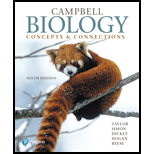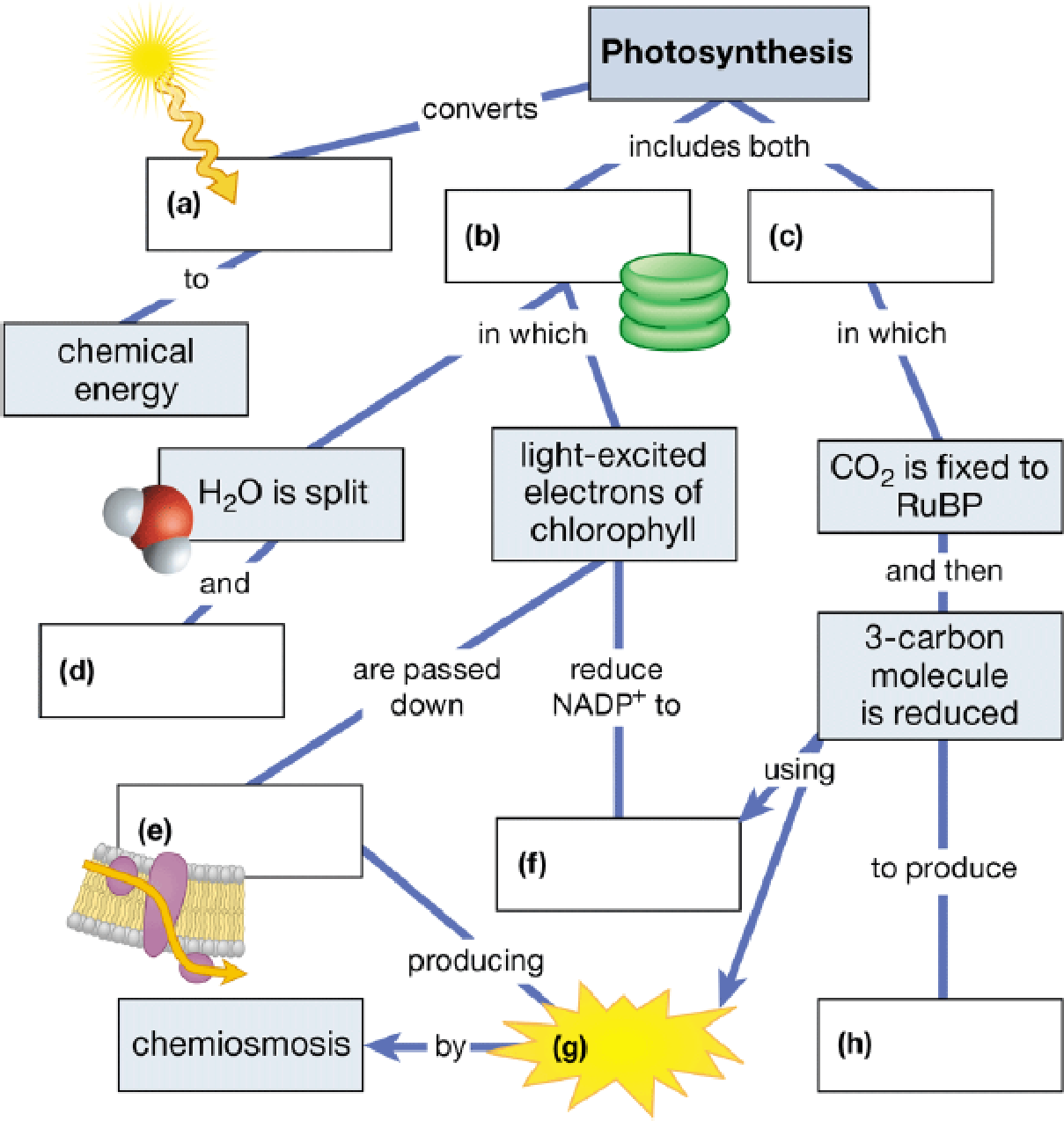
Concept explainers
Complete this summary map of photosynthesis.

To complete: The connect map to summarize the major steps in photosynthesis.
Concept introduction: Photosynthesis is a vital process in primary producers, plants. Plants use light energy and carbon dioxide (CO2) from the atmosphere and produce sugars that are stored in various parts of the plants. The most edible ones are consumed by the primary consumers. Several compounds are converted and recycled in the process of photosynthesis. Several reactions of photosynthesis take place in the chloroplast of the plant cell, which contains the green pigment chlorophyll.
Answer to Problem 1CC
The Fig.1 shows all the key processes in photosynthesis.
Pictorial representation:
The Fig. 1shows the summary of all the processes involved in photosynthesis.

Fig 1: Summary of various steps in photosynthesis.
Explanation of Solution
(a)
Correct answer: Light energy
In the process of photosynthesis, photons from light energy are converted into chemical energy. In the visible spectrum of light, the red and blue wavelengths are used to initiate the reactions of photosynthesis. The light energy is used up to break the water molecule by the process called photolysis of water, which is the first step in photosynthesis.
Hence, the correct answer is light energy.
(b)
Correct answer: Light reactions
Photosynthesis includes two reactions, namely, light-dependent and light-independent reactions. Light reactions are those that are dependent on the incident light energy on the chloroplast. Light reactions include two sub steps. One reaction is the photolysis of water where light energy is used up to break the water molecules to produce an oxygen molecule and protons. The second reaction is where these protons and the energy released during photolysis of water are used up to excite the electrons in the chlorophyll.
Hence, the correct answer is light reactions.
(c)
Correct answer: Calvin cycle
The CBB (Calvin–Benson–Bassham) cycle or Calvin’s cycle is a series of reactions that take place in the stroma of the chloroplast. The Calvin’s cycle is a light-independent reaction, which is also known as the dark reaction. In the Calvin’s cycle, the atmospheric carbondioxide is fixed with ribulose1, 5-bisphosphate to produce two 3-carbon compounds. One of the two 3-carbon compounds is reduced to form another sugar.
Hence, the correct answer is the Calvin cycle
(d)
Correct answer: Oxygen released
During one of the light reactions, that is, photolysis of water, the light energy is used up to break two molecules of water to produce one molecule of oxygen, 4 electrons, and 4 protons (H+). The oxygen molecule then escapes the chloroplast and is released into the atmosphere.
Hence, the correct answer is oxygen released
(e)
Correct answer: Electrontransportchain(ETC)
During the second light reaction of photosynthesis, the electrons released from photolysis of water are passed on through the photosystem II and photosystem I and are then sent to the electron transport chain. In the electron transport chain, the protons released during photolysis of water are used by F0-F1 ATP synthase to produce ATP.
Hence, the correct answer is the electron transport chain (ETC)
(f)
Correct answer: Nicotinamide adenine dinucleotide phosphate (NADPH)
During the second light reaction of photosynthesis, the electrons released from photolysis of water are passed on through the photosystem II and photosystem I, which at the end of photosystem II reduce NAD+ to NADPH. This NADPH is then used up during the hexose monophosphate pathway to produce several sugars, and it is also used during the Calvin’s cycle to produce sugars.
Hence, the correct answer is NADPH
(g)
Correct answer: ATP
The electrons released from photolysis of water are passed on through the photosystem II and then from the photosystem to the electron transport chain. In the electron transport chain, the protons released during photolysis of water are used by F0-F1 ATP synthase present on the thylakoid membrane of the chloroplast to produce ATP. This ATP is used up along with NADPH to produce several sugars in the Calvin’s cycle.
Hence, the correct answer is ATP
(h)
Correct answer: Glyceraldehyde 3-phosphate (G3P)(sugar)
During the Calvin’s cycle, the NADPH and ATP produced during the light reactions and F0-F1 ATP synthase, respectively, are used up to reduce ribulose 1.5-bisphosphate to produce two molecules of G3P. For every 3 molecules of carbondioxide entering the Calvin’s cycle, one G3P is produced. Few G3Ps are sent for the production of 6-carbon sugars and others are recycled back to produce ribulose 1,5-bisphosphate.
Hence, the correct answer is G3P (sugar)
Want to see more full solutions like this?
Chapter 7 Solutions
Campbell Biology: Concepts & Connections (9th Edition)
- 30) A B CDEFG Refer to the accompanying figure. Which of the following forms a monophyletic group? A) A, B, C, and D B) C and D C) D, E, and F D) E, F, and Garrow_forwardMolecular Biology Question. Please help with step solution and explanation. Thank you: The Polymerase Chain Reaction (PCR) reaction consists of three steps denaturation, hybridization, and elongation. Please describe what occurs in the annealing step of the PCR reaction. (I think annealing step is hybridization). What are the other two steps of PCR, and what are their functions? Next, suppose the Tm for the two primers being used are 54C for Primer A and 67C for Primer B. Regarding annealing step temperature, I have the following choices for the temperature used during the annealing step:(a) 43C (b) 49C (c) 62C (d) 73C Which temperature/temperatures should I choose? What is the corresponding correct explanation, and why would I not use the other temperatures? Have a good day!arrow_forwardUsing the data provided on the mean body mass and horn size of 4-year-old male sheep, draw a scatterplot graph to examine how body mass and horn size changed over time.arrow_forward
- Please write a 500-word report about the intake of saturated fat, sodium, alcoholic beverages, or added sugar in America. Choose ONE of these and write about what is recommended by the Dietary Guidelines for Americans (guideline #4) and why Americans exceed the intake of that nutrient. Explain what we could do as a society and/or individuals to reduce our intake of your chosen nutrient.arrow_forwardWrite a 500-word report indicating how you can change the quantity or quality of TWO nutrients where your intake was LOWER than what is recommended by the Dietary Guidelines for Americans and/or the DRIs. Indicate how the lack of the nutrient may affect your health. For full credit, all of the following points must be addressed and elaborated on in more detail for each nutrient: The name of the nutrient At least 2 main functions of the nutrient (example: “Vitamin D regulates calcium levels in the blood and calcification of bones.”) Your percent intake compared to the RDA/DRI (example “I consumed 50% of the RDA for vitamin D”) Indicate why your intake was below the recommendations (example: “I only had one serving of dairy products and that was why I was below the recommendations for vitamin D”) How would you change your dietary pattern to meet the recommendations? – be sure to list specific foods (example: “I would add a yogurt and a glass of milk to each day in order to increase my…arrow_forwardWhy are nutrient absorption and dosage levels important when taking multivitamins and vitamin and mineral supplements?arrow_forward
- I'm struggling with this topic and would really appreciate your help. I need to hand-draw a diagram and explain the process of sexual differentiation in humans, including structures, hormones, enzymes, and other details. Could you also make sure to include these terms in the explanation? . Gonads . Wolffian ducts • Müllerian ducts . ⚫ Testes . Testosterone • Anti-Müllerian Hormone (AMH) . Epididymis • Vas deferens ⚫ Seminal vesicles ⚫ 5-alpha reductase ⚫ DHT - Penis . Scrotum . Ovaries • Uterus ⚫ Fallopian tubes - Vagina - Clitoris . Labia Thank you so much for your help!arrow_forwardRequisition Exercise A phlebotomist goes to a patient’s room with the following requisition. Hometown Hospital USA 125 Goodcare Avenue Small Town, USAarrow_forwardI’m struggling with this topic and would really appreciate your help. I need to hand-draw a diagram and explain the process of sexual differentiation in humans, including structures, hormones, enzymes, and other details. Could you also make sure to include these terms in the explanation? • Gonads • Wolffian ducts • Müllerian ducts • Testes • Testosterone • Anti-Müllerian Hormone (AMH) • Epididymis • Vas deferens • Seminal vesicles • 5-alpha reductase • DHT • Penis • Scrotum • Ovaries • Uterus • Fallopian tubes • Vagina • Clitoris • Labia Thank you so much for your help!arrow_forward
- I’m struggling with this topic and would really appreciate your help. I need to hand-draw a diagram and explain the process of sexual differentiation in humans, including structures, hormones, enzymes, and other details. Could you also make sure to include these terms in the explanation? • Gonads • Wolffian ducts • Müllerian ducts • Testes • Testosterone • Anti-Müllerian Hormone (AMH) • Epididymis • Vas deferens • Seminal vesicles • 5-alpha reductase • DHT • Penis • Scrotum • Ovaries • Uterus • Fallopian tubes • Vagina • Clitoris • Labia Thank you so much for your help!arrow_forwardOlder adults have unique challenges in terms of their nutrient needs and physiological changes. Some changes may make it difficult to consume a healthful diet, so it is important to identify strategies to help overcome these obstacles. From the list below, choose all the correct statements about changes in older adults. Select all that apply. Poor vision can make it difficult for older adults to get to a supermarket, and to prepare meals. With age, taste and visual perception decline. As people age, salivary production increases. In older adults with dysphagia, foods like creamy soups, applesauce, and yogurt are usually well tolerated. Lean body mass increases in older adults.arrow_forwardWhen physical activity increases, energy requirements increase also. Depending on the type, intensity, and duration of physical activity, the body’s requirements for certain macronutrients may change as well. From the list below, choose all the correct statements about the effects of increased physical activity or athletic training. Select all that apply. An athlete who weighs 70 kg (154 lb) should consume 420 to 700 g of carbohydrate per day. How much additional energy an athlete needs depends on the specific activity the athlete engages in and the frequency of the activity. Those participating in vigorous exercise should restrict their fat intake to less than 15%% of total energy intake. Athletes who are following energy-restricted diets are at risk for consuming insufficient protein. The recommendation to limit saturated fat intake to less than 10%% of total energy intake does not apply to athletes or those who regularly engage in vigorous physical activity.arrow_forward
 Concepts of BiologyBiologyISBN:9781938168116Author:Samantha Fowler, Rebecca Roush, James WisePublisher:OpenStax College
Concepts of BiologyBiologyISBN:9781938168116Author:Samantha Fowler, Rebecca Roush, James WisePublisher:OpenStax College
 Biology 2eBiologyISBN:9781947172517Author:Matthew Douglas, Jung Choi, Mary Ann ClarkPublisher:OpenStax
Biology 2eBiologyISBN:9781947172517Author:Matthew Douglas, Jung Choi, Mary Ann ClarkPublisher:OpenStax Biology Today and Tomorrow without Physiology (Mi...BiologyISBN:9781305117396Author:Cecie Starr, Christine Evers, Lisa StarrPublisher:Cengage Learning
Biology Today and Tomorrow without Physiology (Mi...BiologyISBN:9781305117396Author:Cecie Starr, Christine Evers, Lisa StarrPublisher:Cengage Learning Biology: The Dynamic Science (MindTap Course List)BiologyISBN:9781305389892Author:Peter J. Russell, Paul E. Hertz, Beverly McMillanPublisher:Cengage Learning
Biology: The Dynamic Science (MindTap Course List)BiologyISBN:9781305389892Author:Peter J. Russell, Paul E. Hertz, Beverly McMillanPublisher:Cengage Learning Biology (MindTap Course List)BiologyISBN:9781337392938Author:Eldra Solomon, Charles Martin, Diana W. Martin, Linda R. BergPublisher:Cengage Learning
Biology (MindTap Course List)BiologyISBN:9781337392938Author:Eldra Solomon, Charles Martin, Diana W. Martin, Linda R. BergPublisher:Cengage Learning





